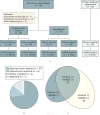Metagenomic next-generation sequencing of synovial fluid demonstrates high accuracy in prosthetic joint infection diagnostics: mNGS for diagnosing PJI
- PMID: 32864114
- PMCID: PMC7437524
- DOI: 10.1302/2046-3758.97.BJR-2019-0325.R2
Metagenomic next-generation sequencing of synovial fluid demonstrates high accuracy in prosthetic joint infection diagnostics: mNGS for diagnosing PJI
Abstract
Aims: The aim of this study was to evaluate the performance of metagenomic next-generation sequencing (mNGS) in detecting pathogens from synovial fluid of prosthetic joint infection (PJI) patients.
Methods: A group of 75 patients who underwent revision knee or hip arthroplasties were enrolled prospectively. Ten patients with primary arthroplasties were included as negative controls. Synovial fluid was collected for mNGS analysis. Optimal thresholds were determined to distinguish pathogens from background microbes. Synovial fluid, tissue, and sonicate fluid were obtained for culture.
Results: A total of 49 PJI and 21 noninfection patients were finally included. Of the 39 culture-positive PJI cases, mNGS results were positive in 37 patients (94.9%), and were consistent with culture results at the genus level in 32 patients (86.5%) and at the species level in 27 patients (73.0%). Metagenomic next-generation sequencing additionally identified 15 pathogens from five culture-positive and all ten culture-negative PJI cases, and even one pathogen from one noninfection patient, while yielding no positive findings in any primary arthroplasty. However, seven pathogens identified by culture were missed by mNGS. The sensitivity of mNGS for diagnosing PJI was 95.9%, which was significantly higher than that of comprehensive culture (79.6%; p = 0.014). The specificity is similar between mNGS and comprehensive culture (95.2% and 95.2%, respectively; p = 1.0).
Conclusion: Metagenomic next-generation sequencing can effectively identify pathogens from synovial fluid of PJI patients, and demonstrates high accuracy in diagnosing PJI.Cite this article: Bone Joint Res 2020;9(7):440-449.
Keywords: Diagnosis; Metagenomic next-generation sequencing; Prosthetic joint infection; Synovial fluid.
© 2020 Author(s) et al.
Figures




Similar articles
-
Optimal selection of specimens for metagenomic next-generation sequencing in diagnosing periprosthetic joint infections.Front Cell Infect Microbiol. 2024 Mar 4;14:1356804. doi: 10.3389/fcimb.2024.1356804. eCollection 2024. Front Cell Infect Microbiol. 2024. PMID: 38500507 Free PMC article.
-
Better choice of the type of specimen used for untargeted metagenomic sequencing in the diagnosis of periprosthetic joint infections.Bone Joint J. 2021 May;103-B(5):923-930. doi: 10.1302/0301-620X.103B5.BJJ-2020-0745.R1. Bone Joint J. 2021. PMID: 33934659
-
Detecting the presence of bacteria in low-volume preoperative aspirated synovial fluid by metagenomic next-generation sequencing.Int J Infect Dis. 2020 Oct;99:108-116. doi: 10.1016/j.ijid.2020.07.039. Epub 2020 Jul 25. Int J Infect Dis. 2020. PMID: 32721535
-
Sonication of Arthroplasty Implants Improves Accuracy of Periprosthetic Joint Infection Cultures.Clin Orthop Relat Res. 2017 Jul;475(7):1827-1836. doi: 10.1007/s11999-017-5315-8. Clin Orthop Relat Res. 2017. PMID: 28290115 Free PMC article. Review.
-
Diagnosis of Coxiella burnetii Prosthetic Joint Infection Using mNGS and ptNGS: A Case Report and Literature Review.Orthop Surg. 2023 Jan;15(1):371-376. doi: 10.1111/os.13600. Epub 2022 Nov 15. Orthop Surg. 2023. PMID: 36377682 Free PMC article. Review.
Cited by
-
Evaluation of the diagnostic utility of metagenomic next-generation sequencing testing for pathogen identification in infected hosts: a retrospective cohort study.Ther Adv Infect Dis. 2024 Feb 23;11:20499361241232854. doi: 10.1177/20499361241232854. eCollection 2024 Jan-Dec. Ther Adv Infect Dis. 2024. PMID: 38404751 Free PMC article.
-
Metagenomic next-generation sequencing assists the diagnosis treatment of fungal osteoarticular infections.Front Cell Infect Microbiol. 2022 Nov 23;12:1072539. doi: 10.3389/fcimb.2022.1072539. eCollection 2022. Front Cell Infect Microbiol. 2022. PMID: 36506031 Free PMC article.
-
Diagnostic Role of mNGS in Polymicrobial Periprosthetic Joint Infection.J Clin Med. 2023 Feb 24;12(5):1838. doi: 10.3390/jcm12051838. J Clin Med. 2023. PMID: 36902625 Free PMC article.
-
What is the appropriate extended duration of antibiotic prophylaxis after two-stage revision for chronic PJI?Bone Joint Res. 2021 Dec;10(12):790-796. doi: 10.1302/2046-3758.1012.BJR-2021-0225.R1. Bone Joint Res. 2021. PMID: 34894718 Free PMC article.
-
Optimal selection of specimens for metagenomic next-generation sequencing in diagnosing periprosthetic joint infections.Front Cell Infect Microbiol. 2024 Mar 4;14:1356804. doi: 10.3389/fcimb.2024.1356804. eCollection 2024. Front Cell Infect Microbiol. 2024. PMID: 38500507 Free PMC article.
References
-
- Tzeng A, Tzeng TH, Vasdev S, et al. . Treating periprosthetic joint infections as biofilms: key diagnosis and management strategies. Diagn Microbiol Infect Dis. 2015;81(3):192–200. - PubMed
-
- Della Valle C, Parvizi J, Bauer TW, et al. . American Academy of Orthopaedic Surgeons. American Academy of Orthopaedic Surgeons clinical practice guideline on: the diagnosis of periprosthetic joint infections of the hip and knee. J Bone Joint Surg Am. 2011;93-A(14):1355–1357. - PubMed
-
- Trampuz A, Piper KE, Jacobson MJ, et al. . Sonication of removed hip and knee prostheses for diagnosis of infection. N Engl J Med. 2007;357(7):654–663. - PubMed
-
- Schäfer P, Fink B, Sandow D, et al. . Prolonged bacterial culture to identify late periprosthetic joint infection: a promising strategy. Clin Infect Dis. 2008;47(11):1403–1409. - PubMed

